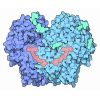[English] 日本語
 Yorodumi
Yorodumi- PDB-2zp0: Human factor viia-tissue factor complexed with benzylsulfonamide-... -
+ Open data
Open data
- Basic information
Basic information
| Entry | Database: PDB / ID: 2zp0 | ||||||
|---|---|---|---|---|---|---|---|
| Title | Human factor viia-tissue factor complexed with benzylsulfonamide-D-ile-gln-P-aminobenzamidine | ||||||
 Components Components |
| ||||||
 Keywords Keywords | HYDROLASE/BLOOD CLOTTING / SERINE PROTEASE / Blood coagulation / Cleavage on pair of basic residues / Disease mutation / EGF-like domain / Gamma-carboxyglutamic acid / Glycoprotein / Hydrolase / Hydroxylation / Protease / Zymogen / Lipoprotein / Membrane / Palmitate / Transmembrane / HYDROLASE-BLOOD CLOTTING COMPLEX | ||||||
| Function / homology |  Function and homology information Function and homology informationactivation of plasma proteins involved in acute inflammatory response / activation of blood coagulation via clotting cascade / coagulation factor VIIa / response to Thyroid stimulating hormone / response to astaxanthin / response to thyrotropin-releasing hormone / response to 2,3,7,8-tetrachlorodibenzodioxine / response to carbon dioxide / response to genistein / serine-type peptidase complex ...activation of plasma proteins involved in acute inflammatory response / activation of blood coagulation via clotting cascade / coagulation factor VIIa / response to Thyroid stimulating hormone / response to astaxanthin / response to thyrotropin-releasing hormone / response to 2,3,7,8-tetrachlorodibenzodioxine / response to carbon dioxide / response to genistein / serine-type peptidase complex / response to vitamin K / positive regulation of platelet-derived growth factor receptor signaling pathway / positive regulation of leukocyte chemotaxis / response to thyroxine / NGF-stimulated transcription / response to cholesterol / cytokine receptor activity / response to growth hormone / positive regulation of positive chemotaxis / Extrinsic Pathway of Fibrin Clot Formation / positive regulation of endothelial cell apoptotic process / positive regulation of blood coagulation / animal organ regeneration / positive regulation of TOR signaling / Transport of gamma-carboxylated protein precursors from the endoplasmic reticulum to the Golgi apparatus / Gamma-carboxylation of protein precursors / Removal of aminoterminal propeptides from gamma-carboxylated proteins / positive regulation of endothelial cell proliferation / serine-type peptidase activity / BMAL1:CLOCK,NPAS2 activates circadian expression / positive regulation of interleukin-8 production / circadian rhythm / protein processing / phospholipid binding / Golgi lumen / response to estrogen / cytokine-mediated signaling pathway / positive regulation of angiogenesis / blood coagulation / response to estradiol / : / protease binding / vesicle / response to hypoxia / positive regulation of cell migration / endoplasmic reticulum lumen / signaling receptor binding / external side of plasma membrane / serine-type endopeptidase activity / calcium ion binding / positive regulation of gene expression / cell surface / extracellular space / extracellular region / membrane / plasma membrane Similarity search - Function | ||||||
| Biological species |  Homo sapiens (human) Homo sapiens (human) | ||||||
| Method |  X-RAY DIFFRACTION / X-RAY DIFFRACTION /  SYNCHROTRON / SYNCHROTRON /  FOURIER SYNTHESIS / Resolution: 2.7 Å FOURIER SYNTHESIS / Resolution: 2.7 Å | ||||||
 Authors Authors | Kadono, S. / Sakamoto, A. / Kikuchi, Y. / Oh-eda, M. / Yabuta, N. / Koga, T. / Hattori, K. / Shiraishi, T. / Haramura, M. / Kodama, H. | ||||||
 Citation Citation |  Journal: LETT.DRUG DES.DISCOVERY / Year: 2005 Journal: LETT.DRUG DES.DISCOVERY / Year: 2005Title: Peptide Mimetic Factor VIIa Inhibitor: Importance of Hydrophilic Pocket in S2 Site to Improve Selectivity aganist Thrombin Authors: Kadono, S. / Sakamoto, A. / Kikuchi, Y. / Oh-eda, M. / Yabuta, N. / Koga, T. / Hattori, K. / Shiraishi, T. / Haramura, M. / Kodama, H. / Esaki, T. / Sato, H. / Watanabe, S. / Itoh, S. / Ohta, M. / Kozono, T. | ||||||
| History |
|
- Structure visualization
Structure visualization
| Structure viewer | Molecule:  Molmil Molmil Jmol/JSmol Jmol/JSmol |
|---|
- Downloads & links
Downloads & links
- Download
Download
| PDBx/mmCIF format |  2zp0.cif.gz 2zp0.cif.gz | 143.3 KB | Display |  PDBx/mmCIF format PDBx/mmCIF format |
|---|---|---|---|---|
| PDB format |  pdb2zp0.ent.gz pdb2zp0.ent.gz | 109.1 KB | Display |  PDB format PDB format |
| PDBx/mmJSON format |  2zp0.json.gz 2zp0.json.gz | Tree view |  PDBx/mmJSON format PDBx/mmJSON format | |
| Others |  Other downloads Other downloads |
-Validation report
| Summary document |  2zp0_validation.pdf.gz 2zp0_validation.pdf.gz | 867.4 KB | Display |  wwPDB validaton report wwPDB validaton report |
|---|---|---|---|---|
| Full document |  2zp0_full_validation.pdf.gz 2zp0_full_validation.pdf.gz | 885.5 KB | Display | |
| Data in XML |  2zp0_validation.xml.gz 2zp0_validation.xml.gz | 28.9 KB | Display | |
| Data in CIF |  2zp0_validation.cif.gz 2zp0_validation.cif.gz | 40.6 KB | Display | |
| Arichive directory |  https://data.pdbj.org/pub/pdb/validation_reports/zp/2zp0 https://data.pdbj.org/pub/pdb/validation_reports/zp/2zp0 ftp://data.pdbj.org/pub/pdb/validation_reports/zp/2zp0 ftp://data.pdbj.org/pub/pdb/validation_reports/zp/2zp0 | HTTPS FTP |
-Related structure data
| Related structure data | 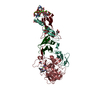 1danS S: Starting model for refinement |
|---|---|
| Similar structure data |
- Links
Links
- Assembly
Assembly
| Deposited unit | 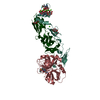
| ||||||||
|---|---|---|---|---|---|---|---|---|---|
| 1 |
| ||||||||
| Unit cell |
|
- Components
Components
-Protein , 3 types, 3 molecules LHT
| #1: Protein | Mass: 17487.076 Da / Num. of mol.: 1 Source method: isolated from a genetically manipulated source Source: (gene. exp.)  Homo sapiens (human) / Gene: F7 / Cell (production host): CHO / Production host: Homo sapiens (human) / Gene: F7 / Cell (production host): CHO / Production host:  |
|---|---|
| #2: Protein | Mass: 28103.256 Da / Num. of mol.: 1 Source method: isolated from a genetically manipulated source Source: (gene. exp.)  Homo sapiens (human) / Gene: F7 / Cell (production host): CHO / Production host: Homo sapiens (human) / Gene: F7 / Cell (production host): CHO / Production host:  |
| #3: Protein | Mass: 24697.398 Da / Num. of mol.: 1 / Fragment: RESIDUES 16-257 Source method: isolated from a genetically manipulated source Source: (gene. exp.)  Homo sapiens (human) / Gene: F3 / Plasmid: PKK223-3 / Production host: Homo sapiens (human) / Gene: F3 / Plasmid: PKK223-3 / Production host:  |
-Sugars , 2 types, 2 molecules 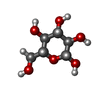
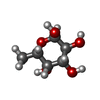

| #4: Sugar | ChemComp-BGC / |
|---|---|
| #5: Sugar | ChemComp-FUC / |
-Non-polymers , 3 types, 309 molecules 
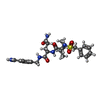



| #6: Chemical | ChemComp-CA / #7: Chemical | ChemComp-PI0 / ( | #8: Water | ChemComp-HOH / | |
|---|
-Experimental details
-Experiment
| Experiment | Method:  X-RAY DIFFRACTION / Number of used crystals: 1 X-RAY DIFFRACTION / Number of used crystals: 1 |
|---|
- Sample preparation
Sample preparation
| Crystal | Density Matthews: 2.57 Å3/Da / Density % sol: 52.07 % |
|---|---|
| Crystal grow | Temperature: 298 K / Method: vapor diffusion, hanging drop / pH: 5 Details: 8 % PEG 5000, 0.1M sodium chloride, 0.005M calcium chloride, 0.1M cacodylate, pH 5.0, VAPOR DIFFUSION, HANGING DROP, temperature 298K |
-Data collection
| Diffraction | Mean temperature: 100 K |
|---|---|
| Diffraction source | Source:  SYNCHROTRON / Site: SYNCHROTRON / Site:  Photon Factory Photon Factory  / Beamline: BL-6B / Wavelength: 1 Å / Beamline: BL-6B / Wavelength: 1 Å |
| Detector | Type: RIGAKU / Detector: IMAGE PLATE / Date: Feb 29, 2000 |
| Radiation | Protocol: SINGLE WAVELENGTH / Monochromatic (M) / Laue (L): M / Scattering type: x-ray |
| Radiation wavelength | Wavelength: 1 Å / Relative weight: 1 |
| Reflection | Resolution: 2.7→40 Å / Num. obs: 19950 / % possible obs: 96.5 % / Biso Wilson estimate: 30 Å2 / Rmerge(I) obs: 0.103 / Net I/σ(I): 4.8 |
- Processing
Processing
| Software |
| ||||||||||||||||||||||||||||||||||||||||||||||||||||||||||||||||||||||||||||||||
|---|---|---|---|---|---|---|---|---|---|---|---|---|---|---|---|---|---|---|---|---|---|---|---|---|---|---|---|---|---|---|---|---|---|---|---|---|---|---|---|---|---|---|---|---|---|---|---|---|---|---|---|---|---|---|---|---|---|---|---|---|---|---|---|---|---|---|---|---|---|---|---|---|---|---|---|---|---|---|---|---|---|
| Refinement | Method to determine structure:  FOURIER SYNTHESIS FOURIER SYNTHESISStarting model: PDB ENTRY 1DAN Resolution: 2.7→14.94 Å / Data cutoff high absF: 1882353.02 / Data cutoff low absF: 0 / Isotropic thermal model: RESTRAINED / Cross valid method: THROUGHOUT / σ(F): 0 / Stereochemistry target values: Engh & Huber
| ||||||||||||||||||||||||||||||||||||||||||||||||||||||||||||||||||||||||||||||||
| Displacement parameters | Biso mean: 18.2 Å2 | ||||||||||||||||||||||||||||||||||||||||||||||||||||||||||||||||||||||||||||||||
| Refinement step | Cycle: LAST / Resolution: 2.7→14.94 Å
| ||||||||||||||||||||||||||||||||||||||||||||||||||||||||||||||||||||||||||||||||
| Refine LS restraints |
| ||||||||||||||||||||||||||||||||||||||||||||||||||||||||||||||||||||||||||||||||
| Xplor file |
|
 Movie
Movie Controller
Controller


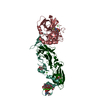
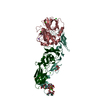
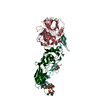
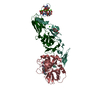
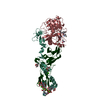
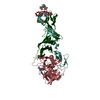
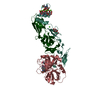
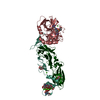
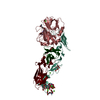
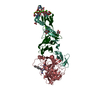
 PDBj
PDBj









